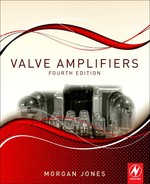Table of Contents
Bipolar Junction Transistors (BJTs)
Chapter 2. Basic Building Blocks
The Common Cathode Triode Amplifier
The Beam Tetrode and the Pentode
Sources and Sinks: Definitions
The Common Cathode Amplifier as a Constant Current Sink (CCS)
The Cathode Follower with Active Load
The Shunt-Regulated Push–Pull Amplifier (SRPP)
Semiconductor Constant Current Sinks
Chapter 3. Dynamic Range: Distortion and Noise
The Fast Fourier Transform (FFT)
Distortion Reduction by Parameter Restriction
Distortion Reduction by Cancellation
Coupling from One Stage to the Next
Distortion and Negative Feedback
Carbon Resistors and Distortion
Chapter 4. Component Technology
General Considerations on Choosing Resistors
General Considerations in Choosing Capacitors
Why Should I Use a Transformer?
General Considerations in Choosing Transformers
Uses and Abuses of Audio Transformers
Individual Elements of the Valve Structure
Thoriated Tungsten Filament Fragility
Adapting the Power Supply to the EC8010 RIAA Stage
Chapter 6. The Power Amplifier
The Push–Pull Output Stage and the Output Transformer
Output Transformer-Less (OTL) Amplifiers
The Scrapbox Challenge Single-Ended Amplifier
Obtaining more than Single Digit Output Power
Driving Higher Power Output Stages
The Bulwer-Lytton Scalable Parallel Push–Pull Amplifier
Obtaining a Clean Signal from Analogue Disc
A Simplified Example RIAA Stage
3180 μs and 318 μs Equalisation
Square Wave Sag and Low Frequency f−3 dB
